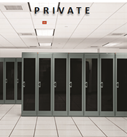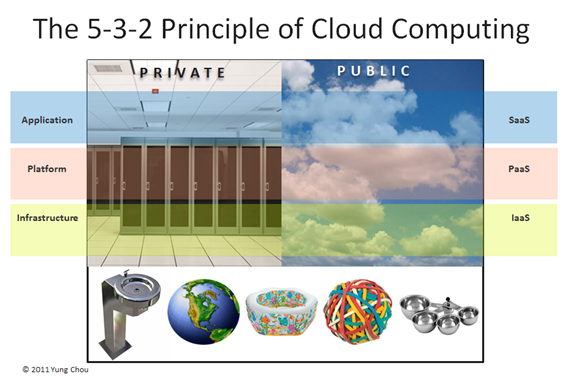I Can See Clearly Now: Concept of Cloud Computing
 The first business to understand cloud computing is to know what the term, service, means since it has been used autonomously and extensively to explain cloud technologies. Service in the context of cloud computing means “capacity on demand” or simply “on demand.” Notice that on-demand here also implies real-time response and ultimately with anytime, anywhere, and any device accessibility. The idea is straightforward. Basically, as a service bell is ringed, the requested resources are magically made available. So, IT as a Service means IT on demand. And now it should be apparent what news as a service, catering as a service, or simply my business as a service means. And we can clearly explain the three cloud computing delivery methods. SaaS means software on demand; simply an application can be readily available for an (authorized) user. PaaS offers a programming environment (or platform) enabling the development and delivery of SaaS. And IaaS empowers a user with the ability to provision infrastructure, i.e. deploy servers with virtual machines, on demand. Further, at an implementation level with current technologies, cloud computing also destines that virtualization (namely an abstraction of the underlying complexities of topology, networking, monitoring, management, etc. from provided services) is put in place. Such that a user can consume or acquire SaaS, PaaS, and IaaS without the need to own and deploy the required hardware, reconfigure the cabling, and so on.
The first business to understand cloud computing is to know what the term, service, means since it has been used autonomously and extensively to explain cloud technologies. Service in the context of cloud computing means “capacity on demand” or simply “on demand.” Notice that on-demand here also implies real-time response and ultimately with anytime, anywhere, and any device accessibility. The idea is straightforward. Basically, as a service bell is ringed, the requested resources are magically made available. So, IT as a Service means IT on demand. And now it should be apparent what news as a service, catering as a service, or simply my business as a service means. And we can clearly explain the three cloud computing delivery methods. SaaS means software on demand; simply an application can be readily available for an (authorized) user. PaaS offers a programming environment (or platform) enabling the development and delivery of SaaS. And IaaS empowers a user with the ability to provision infrastructure, i.e. deploy servers with virtual machines, on demand. Further, at an implementation level with current technologies, cloud computing also destines that virtualization (namely an abstraction of the underlying complexities of topology, networking, monitoring, management, etc. from provided services) is put in place. Such that a user can consume or acquire SaaS, PaaS, and IaaS without the need to own and deploy the required hardware, reconfigure the cabling, and so on.
The term, cloud, regardless public, private, and everything in between means the 5-3-2 principle of cloud computing (see above) is applicable. The 5 characteristics listed in the 5-3-2 principle are the criteria to differentiate a cloud from a non-cloud application, and also concisely outline the benefits of cloud computing. This recognition is the essence of cloud computing. And in my view, much of the confusion in cloud computing discussion has been due to lack of an understanding of the 5-3-2- principle. For instance, many are confused about and mistakenly consider remote access or anything via Internet as cloud computing. This assumption is incorrect and inconclusive. My rule of thumb is that those exhibiting the 5 characteristics are cloud applications and those who don’t are not. Above all, the 5-3-2 principle, or more specifically NIST Definition of Cloud Computing, scopes the subject domain of cloud computing with current technologies and presents a definition that is structured, disciplined, and with clarity.
 So public cloud is a cloud and the 5-3-2 principle applies. The term, public, in the context of cloud computing, refers to Internet, general availability, and for subscription when applicable. Windows Live and Hot Mail for example, are Microsoft SaaS offerings in public cloud for consumers, while Office 365, Microsoft Online Services, and Microsoft Dynamics CRM Online are for businesses. They all are cloud applications because:
So public cloud is a cloud and the 5-3-2 principle applies. The term, public, in the context of cloud computing, refers to Internet, general availability, and for subscription when applicable. Windows Live and Hot Mail for example, are Microsoft SaaS offerings in public cloud for consumers, while Office 365, Microsoft Online Services, and Microsoft Dynamics CRM Online are for businesses. They all are cloud applications because:
- Self-serving since one or an authorized user can create and administer an account without the help from Microsoft IT
- Ubiquitously accessible (using a browser) with an Internet connection
- Running with pools of resources which are transparent to a user regarding where the account and associated data are physically stored, how all resources are connected and managed for the user, etc.
- Elastic to allocate as much capacity as needed or allowed under a service level agreement, and set to inactive for or revoke those accounts not actively used after a set period of time or based on policies
- With a business model that resource availability is based on set quota and costs are based of allocation or usage, when applicable
The 5 characteristics exhibiting in the above mentioned cloud applications are vivid and without ambiguity.
 At the same time, private cloud is also a cloud and dedicated, hence private, to an organization. As explained in Highly Virtualized Computing vs. Private Cloud, ubiquitous access and pay-as-you-go model may not be essential in private cloud. Still the applicability of the 5-3-2 principle to all cloud applications including private cloud should be very clear here. So, for example, the reasoning to answer the following question is actually straightforward.
At the same time, private cloud is also a cloud and dedicated, hence private, to an organization. As explained in Highly Virtualized Computing vs. Private Cloud, ubiquitous access and pay-as-you-go model may not be essential in private cloud. Still the applicability of the 5-3-2 principle to all cloud applications including private cloud should be very clear here. So, for example, the reasoning to answer the following question is actually straightforward.
- Do I need a private cloud if I am already running a highly efficient virtualization solution on premises?
First, with the 5-3-2 principle, we can easily determine if an application is a cloud applications. Then the strategy is to discover which of the 5 characteristics are missing and how relevant they are to the business requirements. For instance:
- Is your virtualization solution self-serving? When deploying virtual machines, (this is basically IaaS or to provision infrastructure on demand,) is IT involved or an authorized user can deploy with DIY? I believe the ability to self-serve will have a long-term and noticeable impact on ROI, and both IT and user productivity. One very important effect of self-serving is that not only an authorized user can allocate resources without operator intervention, perhaps more significantly this authorized user can also de-allocate associated resources without the assistance, i.e. cost, from IT. This ability to de-allocate resources is what IT has not been able to do in a cost-effective fashion in a traditional deployment with physical hardware, since once hardware is allocated, configured, and deployed, it is relatively very costly to reallocate on demand. I consider self-service is a must-have feature and a key consideration of investing private cloud.
And it is certainly up to an organization to decide how critical the 5 characteristics are and if all or selected ones are applicable to a targeted delivery. The lesson here is not necessarily an academic debate if a particular feature like self-service should be a requirement of private cloud. The crucial element is to have a predictable way (namely the 5 characteristics) to identify what are relevant to business requirements.
One interesting observation of cloud computing is that many seem having some understanding, yet few with a complete picture since this is a subject touching very much every aspect of IT. Many can highlight some points of cloud computing, yet few with a structured and disciplined approach of explaining cloud computing since cloud computing is a very complex proposal on both business and technical sides. I believe a productive way to discuss cloud computing is to focus on the fundamentals, and have a clear understanding of what cloud is about and why, before framing it with a particular business or implementation. Employ the 5-3-2 principle to organize the message and describe cloud computing with your own words. You will find out that once grasped the concept, you can navigate through a cloud computing conversation with clarity, substance, and productivity.
